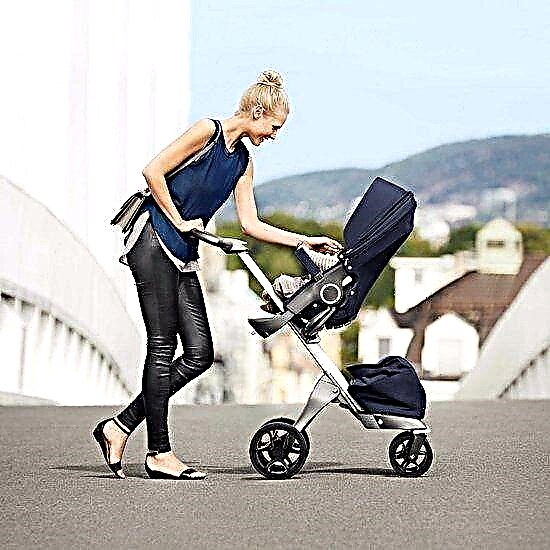
The third trimester of pregnancy is not easy. Every day it becomes more difficult for a woman to carry her baby, which is already difficult to call a crumb. And many people mistakenly believe that this period is best spent on the couch. Getting the right exercise will not only help you feel better, but will also help prepare you for childbirth.

Features of the period
In the third trimester, which begins at the 27th week of pregnancy and lasts until childbirth, all organs and systems of the female body work at maximum load. Preparations for childbirth are underway, and within the framework of this internal preparatory work, the state of the muscles changes, the pelvic bones soften and slightly diverge, the woman's hormonal background changes. As the abdomen grows, the center of gravity changes, which puts an increased load on the spine and legs. A large uterus after 32 weeks of pregnancy props up the diaphragm, which makes the ribs ache and it becomes difficult to take a deep breath.
The pressure of the uterus on all internal organs is palpable: the bladder in a compressed state makes a woman visit the toilet more often, the squeezed intestines "rebel" with constipation, and the stomach - heartburn.
At the same time, there are processes in the body that a woman practically cannot feel - the cervix is preparing for childbirth, gradually smoothing out under the influence of hormones, shortening, the state of the myometrium (uterine tissue) and mammary glands changes. The fetus is actively gaining weight.


The benefits of gymnastics
Gymnastics is very useful for a person, everyone knows about it, even small children. But one thing is hypothetical benefits, and another is knowing exactly how physical exercises affect the state of the expectant mother in the last third of the gestation period:
- improves blood circulation, which reduces the risk of hemorrhoids, varicose veins, as well as fetal hypoxia, because with normal blood circulation, the mother and the fetus receive more oxygen;
- muscles of the back, legs, abdomen become more elastic, which makes it easier to endure the hardships of the last weeks of pregnancy, and also contributes to easier childbirth;
- the cervix matures faster and prepares better for labor opening;
- the postpartum period in women who did gymnastics during pregnancy is easier, they quickly return to pre-pregnant forms and weight;
- physical activity improves intestinal peristalsis, which helps prevent constipation and the onset or exacerbation of such an unpleasant problem of late pregnancy as hemorrhoids;
- adequate physical activity helps to fight insomnia in the third trimester, which, according to statistics, complain about up to 70% of expectant mothers;
- regular gymnastics helps to reduce swelling, reduces physiological (natural) pain. In addition to all of the above, gymnastics in the third trimester helps to control weight gain.

Important! Exercise at a later date should only be done with the knowledge of your doctor. There are individual contraindications, in which neither charging nor other types of load will be beneficial.
Contraindications
With all the obvious benefits of physical activity for expectant mothers, there are situations in which gymnastics in the 3rd trimester is not recommended:
- the state of gestosis - severe swelling, pathological weight gain, high blood pressure, the presence of protein in the urine;
- pathological location of the "child's place" - low placenta, full or partial presentation;
- hypertonicity of the myometrium of the uterus;
- chronic pathologies of the kidneys and cardiovascular system in the expectant mother;
- any deterioration in a woman's well-being - from temporary malaise due to an intestinal disorder to the acute stage of a cold (viral) disease;
- the presence of an obstetric pessary or imposed surgical sutures on the cervix.

Please note that any change in the usual state of health - abnormal discharge, exacerbation of hemorrhoids, weakness or headache - is a reason to cancel the next lesson, consult a doctor and coordinate further physical education with the attending doctor.
What is allowed and what is not?
In the third trimester of pregnancy, the abdomen reaches its maximum size, and, naturally, all types of physical activity that involve tension of the abdominal muscles are strictly prohibited. You can not do exercises in the prone position, and the supine position is also prohibited, since a heavy and large uterus can squeeze the inferior vena cava and aorta, causing aortocaval compression, which can end in tragedy for the woman and child.
Because of the large belly, women can no longer see their legs, and therefore there are great risks of falling and getting injured. A large volume of blood circulating in the body can lead to dizziness, an attack of weakness, and fainting.

Therefore, in the third trimester, it is strictly prohibited:
- strength exercises, weight lifting;
- training on simulators;
- any jumps, including diving;
- load on the abdominal muscles;
- exercises in an unstable position with the need for balance and the risk of losing balance and falling;
- run.

It is possible with the permission of the doctor:
- do gymnastics at home;
- To do yoga;
- perform complexes of exercises on fitball;
- do Pilates;
- attend water aerobics classes and swim.


Please note that the duration of the lesson should not exceed 20-25 minutes.
Features of physical education at a later date
The most important rule that a woman should learn in late pregnancy is no intense exercise. Only a smooth and accurate, unhurried exercise is a guarantee of safety, and right now you need to think about it first.
A woman in no way needs to overexert herself and be too zealous. Overexertion can lead to high blood pressure and heart rhythm disturbances.

It is necessary to follow the basic rules of exercise during this period of pregnancy.
- If you feel unwell during the exercise, you should immediately stop exercising, rest, and if necessary consult a doctor.
- Considering the size of the abdomen and clumsiness, you should not do exercises that require active use of the muscles of the back and lower extremities.
- Exercises for the pelvic and pectoral muscles are most effective in the third trimester.
- The best time to practice is morning and afternoon. Exercising in the evening is not recommended as it can overstimulate the nervous system, leading to insomnia. But breathing exercises for the evening are very good if applied separately from physical exercises.
Never force yourself to do gymnastics through force, so it will not be either pleasure or benefit. Only start exercising when there is a positive attitude.

Antenatal brace will provide additional support. It will help to reduce the load on the back, legs, and make classes more comfortable.
It is imperative to control your own heart rate while performing gymnastic exercises. This may require a heart rate monitor.
Universal gymnastics
A woman can choose any of the many existing physical education programs for pregnant women. We have compiled a selection of the most effective and simple exercises that are easy to do at home without overpaying for the services of an instructor.

Warm up
Any exercise should begin with a warm-up. A well-done warm-up allows you to prepare your muscles for the upcoming exercises. The warm up in the third trimester should include the following.
- Raising hands and stretching after them upward, followed by relaxation. Do not raise your arms too harshly - this can lead to poor circulation.
- Leaving the arms to the sides and stretching them to the right and left, followed by relaxation.
- Rotation of the arms and legs in a circle - from the hands to the shoulder and from the feet to the knee.
In the warm-up, include walking in place for 2-3 minutes, light shallow bends without bending forward, backward and to the sides, make circular movements with your head to the sides.
After completing the warm-up, you need to rest a little, restore your breathing and gradually move on to exercises, starting with simple ones and ending with complex ones.

Exercises
The main complex includes exercises to maintain the tone of the muscles of the pelvic floor, lower back, back and legs.
- "Cat". The woman takes a pose on the floor with support on her hands and knees. First, the back bends down in the lower back - an inhalation is made, then the back is "rounded", the head goes down - an exhalation is made. The exercise is repeated several times.
- "Vane". This exercise can be done while standing or sitting on the floor. Hands are fixed at the back of the head, elbows are maximally combined in front of the face. On a deep breath, the woman spreads her elbows to the sides, and on a slow and smooth exhalation, the elbows are brought back, returned to their original position.
- "Bell". Feet shoulder width apart, hands fixed on the belt. The woman bends her knees a little, pulls the pelvis to the sides, back and forth. You can write out a figure eight with your hips, but with a reasonable, gentle amplitude.
- "Butterfly". Position - sitting on the floor. A woman should rest her hands on the floor from behind in a way that is convenient for her. From this position, they make turns with the body to the sides, slightly spreading their arms to the sides.
- "Sprinter". This exercise is very similar to the sprinter's pose before the start. The woman drops to all fours. He takes a calm breath, and as he exhales, he slowly sits on his heels, leaving his hands resting on the floor. As she inhales, she again takes a pose on all fours.
- Fitball exercises. Such exercises in the third trimester can help reduce stress on the back and normalize the condition, reduce back aches and pain in the diverging ribs. Most of the exercises are performed while sitting on a ball. Trace circles and eights with your pelvis while sitting comfortably on a gymnastic ball. Remember to stretch your arms forward to maintain balance.


Finish with a few yoga asanas. For the third trimester, only those poses that involve training the muscles of the pelvis and legs are ideal. If the expectant mother has never done yoga before, then it is advisable to get at least one specialist advice. Use the following poses.
- Take a sitting position on the floor, bend your knees and spread them apart so that the inside of the knees is turned towards the floor (W-shaped). Pull your feet to the buttocks, smoothly and gently and return them to their place.
- Sitting on the floor, bring your legs together. Try to keep your back straight and your neck straight. Keeping yourself in line, give yourself a few minutes to relax and repeat the technique.
Breathe properly while doing yoga exercises, otherwise there will be little benefit from them. Inhalation should be both chest and abdominal, but always even, deep, exhalation - slow and calm.

Kegel exercises
A set of exercises proposed by Arnold Kegel, an American gynecologist of German origin, helps prepare the pelvic floor muscles for childbirth. This will avoid tears and birth trauma, make the genital tract more elastic. Exercise is not suitable for pregnant women who are at risk of premature birth, have a pessary in place and other complications of pregnancy.
That is why it is important to definitely consult with your gynecologist before adding Kegel exercises to your daily gymnastics.
Among the exercises described by Arnold Kelegem, in the third trimester, special attention should be paid to those techniques that allow you to train the ligaments and pelvic muscles, strengthen the muscles of the vagina:
- strain and relax the muscles of the perineum, while with each subsequent approach, increase the tension time in comparison with the relaxation time;
- alternately strain and relax the muscles of the anus and vagina;
- take a sitting position on the floor, cross your legs and slightly push while inhaling, relaxing, exhale;
- take a lying position on a firm surface and slightly lift the pelvis simultaneously with the tension of the muscles of the perineum.


When doing Kegel exercises, remember that holding your breath is forbidden - only even, measured and calm breathing will ensure proper training of the muscles necessary for childbirth.
Breathing techniques
Respiratory gymnastics in the third trimester can be used as a separate type of training, or in combination with other types of load. There are no contraindications for breathing exercises, the only category of women who definitely need a doctor's consultation before starting classes are women with bronchial asthma.
Breathing practices will help a woman not only facilitate the last weeks of gestation, but also help in childbirth - intensive, correct breathing stimulates the production of serotonin, which has a natural analgesic effect.
What techniques can you practice? Yes, almost all of which are included in the training program for childbirth behavior.
- Dog breath. Frequent shallow breaths with an open mouth. And inhale and exhale, preferably through the mouth and nose.
- Long breaths and smooth, prolonged exhales. Inhale in a 1-2-3-4 count and exhale in a 1-2-3-4-5-6 count. Then, during labor, such breathing will help to naturally numb the contractions. In the meantime, you can use the exercises during training fights, if any.
- Put out the candle. Imagine that there is a lighted candle in front of your face. Take a deep breath and quickly push the air out through your mouth in short portions, as if you were extinguishing one or more candles.

It is very important to monitor your well-being during breathing exercises. If you feel dizzy, fingers become numb, you need to stop the exercise and consult a specialist.
In each antenatal clinic there is a school for expectant mothers, where you can get skills in breathing exercises for free and coordinate the load with a gynecologist and therapist.

Recommendations
For each pregnant woman, the level of load needs an individual one. There is no exercise that is beneficial to two different women. Therefore, it is worth choosing such a complex for yourself, performing which a woman will feel as comfortable as possible. If the exercise is unpleasant, if it is three times useful, you should not do it.
- If the exercises are given easily and naturally, the woman is in good physical shape, she still should not complicate and burden them with additional load. The line between acceptable and unacceptable is too thin.
- The desire to experiment is commendable, but not in the last trimester of pregnancy. You should not use exercises that are not coordinated with the attending physician and have not received approval from him.
- Gymnastics in the open air is very useful, on the street, if you have a private house, and it is summer outside. If it's winter days, you have an ordinary apartment in a high-rise building and there is no balcony, exercise in a well-ventilated room so that your body receives as much oxygen as possible during exercise.
- When composing your own training program, always remember that the load should be proportional: the proportion of warm-up in the total time of the class is 15%, about half of the charging time is allocated for the main exercises, Kegel exercises - 15%, but no more than 5 minutes at a time, and the rest of the time with a clear conscience can be devoted to yoga asanas and breathing practices.

Avoid situations where the warm-up time is insufficient or the amount of general exercises is less than the duration of Kegel exercises and exercises on fitball.
Remember to keep your body in good shape throughout the day. Morning exercises, even if done according to all the rules, will not bring much benefit if the woman spends the rest of the day on the couch with a box of cookies. Try to distribute the load so that there is time for walking, for household chores, for other activities that will be enjoyable and beneficial for the woman and her loved ones.
If a woman's program includes swimming, remember that the second half of the third trimester is not the best time to visit the pool. Completely imperceptibly, at any moment the mucous plug that closes the cervical canal can come off, and then neither baths, nor reservoirs, nor the pool will be shown - the probability of infection entering the uterine cavity increases.
Any physical activity should be stopped if a woman has a leakage of amniotic fluid and if the cervix is shortened ahead of time.

Exercises for pregnant women in the third trimester, see the next video.



